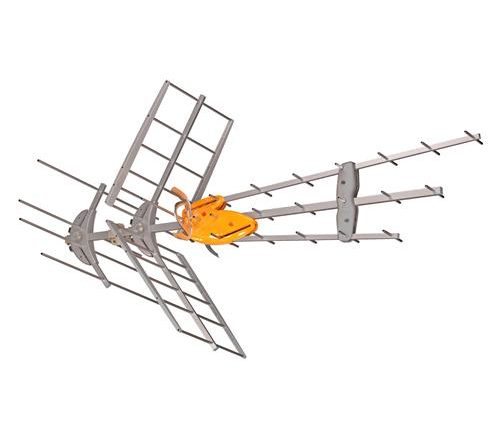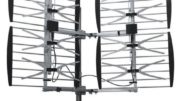I love it when people want to be precise. Most people will tend to call any large antenna with a lot of busy stuff on it (like the one pictured at top) a “yagi.” These are the same people who have led the cable multiplexer to be called a “cable modem.” Folks, it’s not really a modem, a modem modulates and demodulates. That’s how it got its name. But the cable modem does the same task done by a modem in the 1990s, so the name stuck. I’m digressing. The point is that there is a technical difference between a “yagi” antenna and a “log periodic” antenna and it is important.
A Yagi antenna

The Yagi antenna, so named for one of the two people who initially invented it, is an antenna design that focuses as much power as possible on either a single small element or a group of small elements. It’s characterized by “directors” (the smaller pieces at the front) as well as “reflectors” which are the angled pieces in the middle or back. All of these are referred to as “passive radiators.” They act like a lens in a way. By narrowing the area that an antenna can “see,” more signal gets to the receiving element, which can be as small as a foot or two wide.
Yagi antennas come in many sizes and shapes but they all work the same. The advantage of a true Yagi antenna is its ability to work very well in a small range of frequencies, making them useful for UHF or ham radio.
Log Periodic antenna

The Log Periodic antenna tends to look a lot like a Yagi antenna but electrically is quite different. In a true Yagi antenna, there is usually a small number of elements doing the work, while in a log periodic antenna, every one of the horizontal elements you see is actually receiving elements. This creates a large array without any gaps in it, which can be most helpful in receiving a wide range of frequencies.
Here’s where it gets confusing. Log periodic antennas are usually arranged in such a way so that some of the elements are also passive radiators, which means they help bounce signals to the other elements. So in that sense the log periodic is acting like a Yagi.
Hybrid antennas
The confusion continues. The antenna you see above you is technically a hybrid of a Yagi and log periodic antenna. The small portion at left is a Yagi antenna, with short directors focused on a single point and angled reflectors. That part is used for UHF. Everything to the right of that is a log periodic array, with each of the elements actually receiving a different channel.
This sort of hybrid was very popular in the 1950s, 1960s, and 1970s before the rise of cable TV. It allowed for reception all the way from channel 2 to channel 83. The Yagi portion handled channels 14-83 while the log periodic portion handled channels 2-13. Most markets have stopped broadcasting in the range from channels 2-6, and many have stopped broadcasting in the 7-14 range. All TV broadcasting has stopped above channel 51. So, even if you are using a log periodic antenna, you wouldn’t need as many elements.
The easy way to tell
If you’re walking down the street looking at antennas on rooftops, look for wires going to each element. Do you see wires? If so, that’s a log periodic. If you don’t, you probably have a Yagi.
Which is better?
It really depends on how you’re going to use it. Many large antennas have log periodic elements to pull in those low frequency VHF channels, but you hardly ever see log periodic antennas for UHF because those frequencies respond equally well to the simpler Yagi design.
Is it ok to call it a Yagi anyway?
Yeah, most people do. Don’t sweat it.
Shop for the antenna you need at Solid Signal
Solid Signal has the best selection of all the best antennas, including yagis and log-periodics, or whatever you choose to call them. Shop the great selection at SolidSignal.com now!






